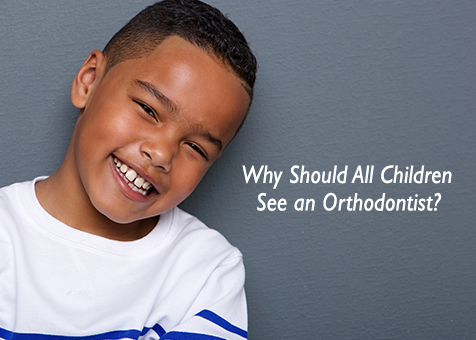
“At first, many parents often think seven is pretty young to see an orthodontist,” says Dr. Robert Gire. “But from our end, it’s actually the ideal time. When the baby teeth start to fall out and the permanent teeth begin to erupt, we can start to form a picture of how everything will fit together. We can determine if your child might have anything that is cause for concern, and either craft a treatment plan or monitor until treatment is needed.”
Even if you can’t visually see anything wrong in your child’s mouth, an orthodontist will have the proper skills and expertise to know if a problem might be lurking under the surface, and can identify problems that a dentist may not be able to recognize.
We simply can’t rely on visual inspections alone, nor can you as a parent rely on your child to tell you if something may be off with his or her bite. Some orthodontic issues can be easily detected by the eye, but others take the training of an orthodontist to spot.
At an initial consultation, the orthodontist can determine if there are, or might be, crooked teeth, if there is adequate room for all of the permanent teeth to erupt, if the jaw is misaligned, or if there are any negative effects from habits such as thumb sucking, just to name a few.
“The things we look for at a young age aren’t always noticeable to the eye or even to the patient him or herself,” says Dr. Gire. “But, starting a relationship with an orthodontist at an early age can prevent today’s small problems from becoming tomorrow’s big, and expensive, problems.”
Early detection and diagnosis can help an orthodontist formulate a treatment plan that can target the problem at the right time to have the most impact. You may not notice your child’s jaw is too small for all of their permanent teeth, but if you wait until the child is a teen to seek treatment, it might make treatment more complicated and expensive. An orthodontist, however, can begin treatment while the jaw is still growing, helping to make room for all of the teeth without more serious interventions.
Most children likely will not require serious orthodontic work at the age of seven. But for those who do need help, an orthodontist can ensure your child’s treatment is the most effective, and there will likely be a way to avoid future costly and complicated treatments.
“I hear it all the time: ‘there’s no reason to see an orthodontist until all the baby teeth fall out,’” says Dr. Gire. “By then, it may actually be too late. If we can correct a simple problem early on, the patient may be able to avoid the future removal of teeth, excessive treatment time in braces later on, and/or surgery depending on the severity.”
While it is never too late to wear braces to improve the smile, there is an ideal time to begin orthodontic treatment. Your orthodontist will know exactly when that is. If your child is over the age of seven and hasn’t yet seen an orthodontist, schedule a free consultation today at our La Habra (562-690-1199) or Chino Hills office (909-393-9911).

